China/India alternative vs valuation
While China and India are definitely the flavor of the day and have had
amazing runs:
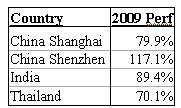
Source: Bloomberg
China and India have much more expensive valuations as a result (60-65%
higher P/E multiples):
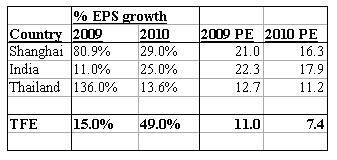
Source: Bloomberg / Quest Management, Inc.
In reality, many Thai industrial companies which have little or no exposure
to the volatile domestic sector are excellent, world-focused, and can be
bought at a significant discount to Chinese or Indian companies because they
are overlooked and under-owned.
We believe that politics will be more stable in Thailand than in China over
the next five to ten years. As Chinese workers’ lifestyles improve and they
move up the hierarchy of needs, it is likely that they will feel
dissatisfied with their extremely regimented lifestyle and lack of personal
freedoms. Unlike China, Thais have enjoyed great personal freedom and
democracy for the last 77 years.
Earnings Growth and Capital Gains
When I arrived in Thailand over 20 years ago, Thai investors and brokers
told us not to waste our time trying to estimate the earnings of Thai
companies, because prices move on insider trading, not earnings.
In a new study, we recently looked at all stocks listed from year-end 2002
until year-end 2007 (five years), to see the relationship between EPS growth
and total return (see below).
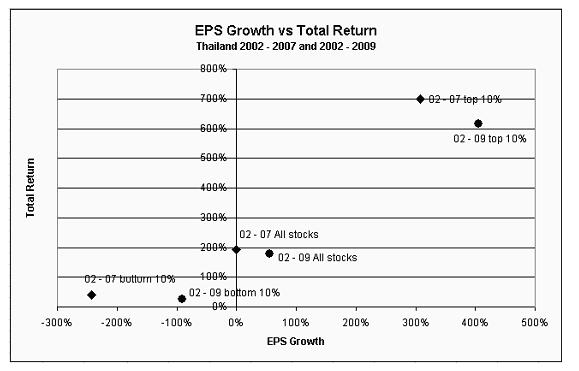
Earnings Growth vs Total Return
Source: Bloomberg & Quest Management
Of 220 stocks that had earnings per share (EPS) and price data, the top 10%
grew their earnings by an average of 308% and made an average total return
of 699%.
The worst earnings performance stocks drove average EPS from 0.33 baht per
share to a loss of 0.47 baht per share (-242% growth). This bottom 10% had
average total returns of only 41%.
The SET Index had a total return of 194%, so we can see that the Thai market
really rewards companies that produce big earnings growth and punishes
companies with bad earnings.
Data from 2003 until 2009 shows similar trends (see above).
What’s going on in the Thai Economy?
In terms of government stimulus, Thailand is much closer to the US rather
than the Chinese timetable. While the Thai government passed two huge
stimulus programs totalling $46 billion (18.4% of GDP), actual spending to
date only amounts to about $4 billion. In 2010, the budget calls for
spending about 5% of GDP. With this level of government spending in mind,
the consensus real GDP growth is 3.5% for 2010 and 4.5% for 2011.
In addition, macroeconomic policy after the 1997 currency crisis has forced
Thai banks to focus on basic banking business, so there are no banking
problems in Thailand.
We also feel that, given the huge printing of US dollars with no underlying
economic activity, the Thai baht will continue to strengthen against the US
dollar.
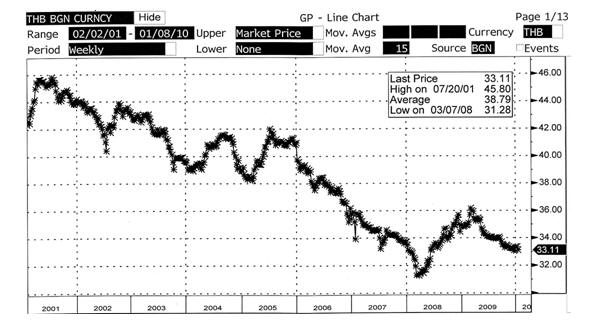
Thai Baht per US Dollar
Source: Bloomberg
We think that dollar weakness will
also translate into higher commodity prices even in the face of moderate
demand, because commodities are traded in US dollars.
We believe that China and other manufacturing nations that have very large
US dollar surpluses are actively using those excess dollars (soon to be
devalued) to buy several years’ worth of raw material inventories.
This explains why we have oil at $79/bbl off a bottom of $30, zinc at $2,530
per ton off a low of $1,047, rice at $600/ton off a low of $300, and the BDI
shipping index at 3,000 off a low of 663.
It is also a brilliant strategy by manufacturers to lock in their largest
costs during a period of comparatively weak prices for future expenses that
that they know they will incur, while simultaneously diversifying out of the
US dollar.
Inflation in Thailand is still low, due to the slower spending of the
government stimulus and substantial slack in manufacturing capacity
utilization (see below).
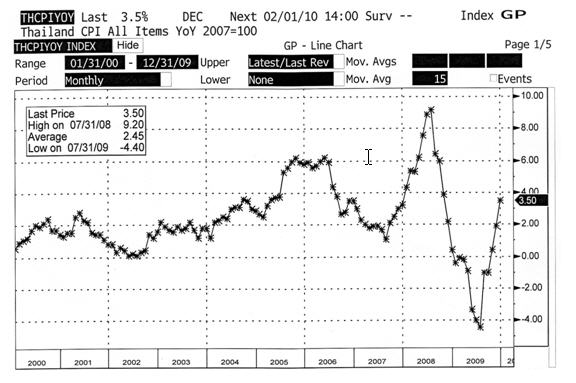
Thailand Consumer Price Inflation
Source: Bloomberg
The big unknown is politics. Political uncertainty primarily affects the
retail and entertainment sectors, as well as infrastructure, because
consumers tend to pull back on spending and bureaucrats prefer to delay
action on major projects when there is no clear government leadership.
However, overall GDP growth under political uncertainty has held up very
well until the global banking meltdown in 2008 (see below).
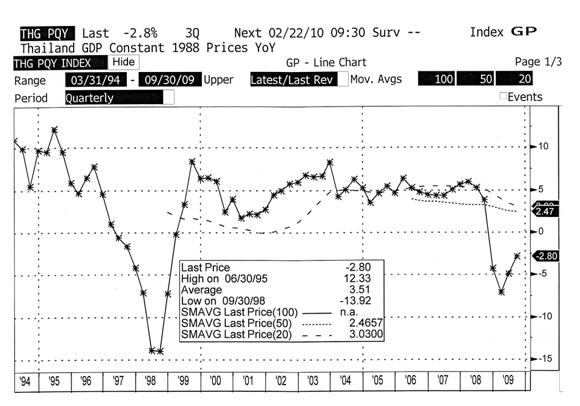
Thailand Real GDP Growth YOY
Source: Bloomberg
This is why we prefer to avoid infrastructure, retail and
entertainment-related stocks at this time, as we believe they will bear the
brunt of negative consumer sentiment.
Although investors are bearish right now, we continue to maintain a very
substantial long exposure to the market because:
• Thai interest rates are lower than inflation, yeilding Thais a negative
real rate of return on deposits. We think Thais will therefore invest in the
stock market.
• The government stimulus program continues to inject massive liquidity into
the Thai economy. Liquidity almost always finds its way into stock prices.
• Thai companies have focused on reducing their fixed costs so that, even
though their revenues have dropped significantly, they are able to show a
net profit.
• A U.S./world recovery will be good for Thai exporters. Thai exports are
split evenly between Japan, Europe, and the US. Export companies that we
follow are currently trading at only 5.3 to 8 times earnings.
• Most importantly, stocks are cheap right now. The index is still 18.6%
below its November 2007 peak. And did I mention that the weighted average
P/E on 2010 earnings for our portfolio is now only 7.4x with 49% profit
growth?





